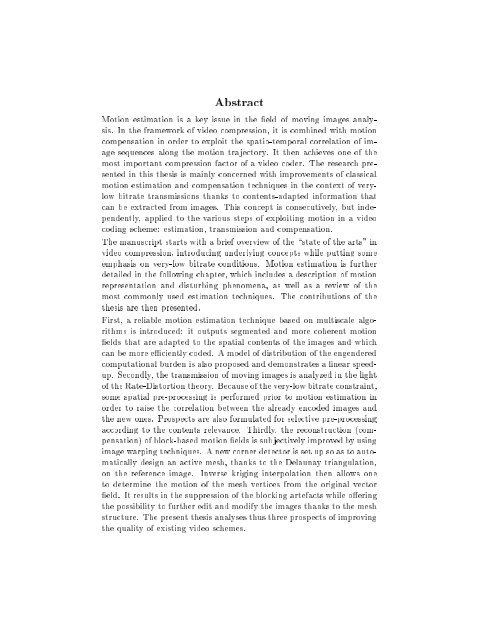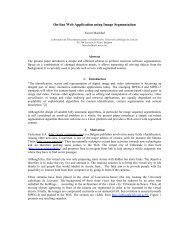motion estimation and compensation for very low bitrate video coding
motion estimation and compensation for very low bitrate video coding
motion estimation and compensation for very low bitrate video coding
You also want an ePaper? Increase the reach of your titles
YUMPU automatically turns print PDFs into web optimized ePapers that Google loves.
Abstract<br />
Motion <strong>estimation</strong> is a key issue in the eld of moving images analysis.<br />
In the framework of <strong>video</strong> compression, it is combined with <strong>motion</strong><br />
<strong>compensation</strong> in order to exploit the spatio-temporal correlation of image<br />
sequences along the <strong>motion</strong> trajectory. It then achieves one of the<br />
most important compression factor of a <strong>video</strong> coder. The research presented<br />
in this thesis is mainly concerned with improvements of classical<br />
<strong>motion</strong> <strong>estimation</strong> <strong>and</strong> <strong>compensation</strong> techniques in the context of <strong>very</strong><strong>low</strong><br />
<strong>bitrate</strong> transmissions thanks to contents-adapted in<strong>for</strong>mation that<br />
can be extracted from images. This concept is consecutively, but independently,<br />
applied to the various steps of exploiting <strong>motion</strong> in a <strong>video</strong><br />
<strong>coding</strong> scheme: <strong>estimation</strong>, transmission <strong>and</strong> <strong>compensation</strong>.<br />
The manuscript starts with a brief overview of the \state of the arts" in<br />
<strong>video</strong> compression, introducing underlying concepts while putting some<br />
emphasis on <strong>very</strong>-<strong>low</strong> <strong>bitrate</strong> conditions. Motion <strong>estimation</strong> is further<br />
detailed in the fol<strong>low</strong>ing chapter, which includes a description of <strong>motion</strong><br />
representation <strong>and</strong> disturbing phenomena, as well as a review of the<br />
most commonly used <strong>estimation</strong> techniques. The contributions of the<br />
thesis are then presented.<br />
First, a reliable <strong>motion</strong> <strong>estimation</strong> technique based on multiscale algorithms<br />
is introduced: it outputs segmented <strong>and</strong> more coherent <strong>motion</strong><br />
elds that are adapted to the spatial contents of the images <strong>and</strong> which<br />
can be more e ciently coded. A model of distribution of the engendered<br />
computational burden is also proposed <strong>and</strong> demonstrates a linear speedup.<br />
Secondly, the transmission of moving images is analyzed in the light<br />
of the Rate-Distortion theory. Because of the <strong>very</strong>-<strong>low</strong> <strong>bitrate</strong> constraint,<br />
some spatial pre-processing is per<strong>for</strong>med prior to <strong>motion</strong> <strong>estimation</strong> in<br />
order to raise the correlation between the already encoded images <strong>and</strong><br />
the new ones. Prospects are also <strong>for</strong>mulated <strong>for</strong> selective pre-processing<br />
according to the contents relevance. Thirdly, the reconstruction (<strong>compensation</strong>)<br />
of block-based <strong>motion</strong> elds is subjectively improved by using<br />
image warping techniques. A new corner detector is set up so as to automatically<br />
design an active mesh, thanks to the Delaunay triangulation,<br />
on the reference image. Inverse kriging interpolation then al<strong>low</strong>s one<br />
to determine the <strong>motion</strong> of the mesh vertices from the original vector<br />
eld. It results in the suppression of the blocking artefacts while o ering<br />
the possibility to further edit <strong>and</strong> modify the images thanks to the mesh<br />
structure. The present thesis analyses thus three prospects of improving<br />
the quality of existing <strong>video</strong> schemes.





